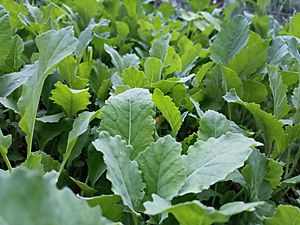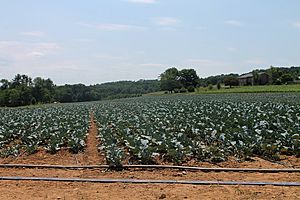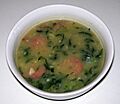Collard (plant) facts for kids
Quick facts for kids Collard |
|
|---|---|
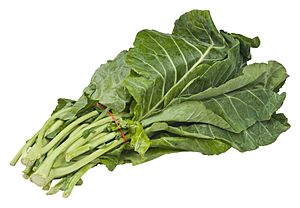
A bundle of collard greens
|
|
| Species | Brassica oleracea |
| Cultivar group | Acephala Group |
| Origin | Greece |
| Cultivar group members | Many; see text. |
Collard refers to certain types of loose-leafed plants. These plants are part of the Brassica oleracea species. This is the same plant family as many common vegetables. These include cabbage and broccoli. Collard is a member of the Viridis Group of Brassica oleracea.
People grow collard plants for their large, dark-green leaves. These leaves are edible. They are a popular food crop in many places. These include Kashmir, Brazil, Portugal, Zimbabwe, and the southern United States. They are also eaten in Tanzania, Kenya, Uganda, the Balkans, Italy, and northern Spain. People have eaten collard greens for at least 2000 years. The ancient Greeks grew several types of collard and kale.
Contents
What Are Collards?
The name "collard" is used for many Brassica oleracea plants. These plants do not form a tight "head" like cabbage. This is why they are sometimes called "Acephala," which means "without a head" in Greek. Because they don't form a head, collards can handle humid weather better. They are also less likely to get fungal diseases.
Collard plants are usually biennial. This means they live for two years in places with winter frost. Some types can be perennial (living for many years) in warmer areas. They have a tall stalk that can grow over two feet high. Some Portuguese types can even reach six feet! Collards look very similar to kale.
Some popular types of collard greens are 'Georgia Southern', 'Vates', and 'Morris Heading'. In Africa, collards are often called sukuma in East Africa. They are called muriwo or umBhida in Southern Africa.
Growing Collards
Farmers grow collard plants for their thick, slightly bitter leaves. You can find collard greens all year. But they taste best and have more nutrients in colder months. This is especially true after the first frost. For the best texture, people pick the leaves before they get too big. Older leaves are thicker and cooked differently from younger ones. The age of the leaf does not change its flavor.
The taste and texture also depend on the type of collard. For example, couve manteiga and couve tronchuda are very popular in Brazil and Portugal. After the Second World War, fewer types of collards were grown in the USA. Only about five types were common. However, many farmers and seed savers kept seeds of older varieties. The US government also kept seed collections.
In the Appalachian Mountains in the Southern United States, "cabbage collards" are popular. These have yellow-green leaves and form a partial head. Since the early 2000s, there have been projects to save rare collard seeds. These projects also help more types of collards be grown again.
What's Inside Collards?
| Nutritional value per 100 g (3.5 oz) | |
|---|---|
| Energy | 137 kJ (33 kcal) |
|
5.6 g
|
|
| Sugars | 0.4 g |
| Dietary fiber | 4 g |
|
0.7
|
|
|
Protein
|
2.7 g
|
| Vitamins | Quantity
%DV†
|
| Vitamin A equiv.
beta-Carotene
lutein zeaxanthin
|
48%
380 μg
42%
4513 μg6197 μg
|
| Thiamine (B1) |
3%
0.04 mg |
| Riboflavin (B2) |
9%
0.11 mg |
| Niacin (B3) |
4%
0.58 mg |
| Pantothenic acid (B5) |
4%
0.22 mg |
| Vitamin B6 |
10%
0.13 mg |
| Folate (B9) |
4%
16 μg |
| Vitamin C |
22%
18 mg |
| Vitamin E |
6%
0.9 mg |
| Vitamin K |
388%
407 μg |
| Minerals | Quantity
%DV†
|
| Calcium |
14%
141 mg |
| Iron |
9%
1.13 mg |
| Magnesium |
6%
21 mg |
| Manganese |
24%
0.51 mg |
| Phosphorus |
5%
32 mg |
| Potassium |
4%
117 mg |
| Sodium |
1%
15 mg |
| Zinc |
2%
0.23 mg |
| Other constituents | Quantity |
| Water | 90.2 g |
|
Full Link to USDA Database entry
|
|
| †Percentages estimated using US recommendations for adults. | |
Raw collard greens are mostly water (90%). They also have some carbohydrates (6%) and protein (3%). They have very little fat. Just like kale, collard greens have a lot of vitamin K. A 100 gram serving gives you 388% of the daily amount you need!
Collard greens are also rich in other important nutrients. These include vitamin A, vitamin C, and manganese. They are also a good source of calcium and vitamin B6. A 100 gram serving of cooked collard greens has 137 kilojoules of energy.
How People Eat Collards
East Africa
In Tanzania, Kenya, and Uganda, collard greens are called sukuma. People usually lightly cook sukuma in oil until it's soft. They add onions and salt for flavor. It's often served as the main side dish with meat. This can be fish, chicken, beef, or pork. In Congo, Tanzania, and Kenya, thinly sliced collard greens are a main side dish for sima or ugali. This is a popular cake made from maize flour.
Southern and Eastern Europe
Collards have been grown in Europe for thousands of years. The ancient Greeks and Romans ate them. In Montenegro, Dalmatia, and Herzegovina, collard greens are called raštika or raštan. They were a common vegetable. People especially like them in winter. They stew them with smoked mutton or cured pork, root vegetables, and potatoes. In Turkey, collards are called kara lahana ("dark cabbage"). They are a main food in the Black Sea area.
Southern United States
Collard greens are a staple vegetable in Southern U.S. cooking. They are often cooked with other green leaf vegetables. These include spinach, kale, turnip greens, and mustard greens. This dish is sometimes called "mixed greens".
People typically cook collards with smoked and salted meats. Examples are ham hocks or smoked turkey. They also add diced onions, vinegar, salt, and pepper. Some cooks even add a little sugar. Traditionally, people eat collards on New Year's Day. They eat them with black-eyed peas and cornbread. This is thought to bring wealth in the new year. The cornbread is used to soak up the "pot liquor". This is a broth from the cooked collards that is full of nutrients. Collard greens can also be sliced thin and fermented. This makes a collard sauerkraut. It is often cooked with flat dumplings.
Zimbabwe
In Zimbabwe, collard greens are called mbida in Ndebele and muriwo in Shona. The plant grows well in almost all conditions there. Many people grow it in their gardens. It is commonly eaten with sadza. This is similar to ugali or polenta. Mbida is usually softened in boiling water. Then it is fried and mixed with cooked onions or tomatoes. Some people add beef, pork, or other meat to the mbida mix. This makes a type of stew. Most people in Zimbabwe eat mbida often. It is cheap and easy to grow at home.
Brazil and Portugal
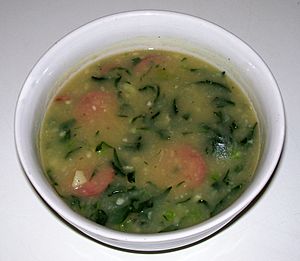
In Portuguese and Brazilian cooking, collard greens (or couve) are a common side dish. They go well with fish and meat. They are a standard side dish for feijoada. This is a popular stew made with pork and beans. The collard types grown in Brazil and Portugal are likely a special group of Brassica oleracea called the Tronchuda Group.
Thinly sliced collard greens are also a main ingredient in a popular Portuguese soup. This soup is called caldo verde ("green broth"). For this soup, the leaves are cut into very thin strips. They are added to the other ingredients about 15 minutes before serving.
Kashmir Valley
In Kashmir, collard greens are called haakh. They are part of most meals. People pick the young, tender leaves in early spring. These are called kaanyil haakh. As the plant grows, older leaves are picked regularly. In late autumn, the top part of the stem and its leaves are removed.
There are several dishes made with haakh. A common dish eaten with rice is haak rus. This is a soup of whole collard leaves. It is cooked simply with water, oil, salt, green chilies, and spices.
Collards in History
Collard greens came to the United States on ships with enslaved Africans. During that time, collards were one of the most common plants grown in home gardens. They helped add to the food given by plantation owners. Greens were widely used because the plants could survive through the winter. They could also handle the heat of a southern summer better than spinach or lettuce.
Collards in Culture
In the United States, collard greens are a symbol of African-American culture and identity. For example, jazz musician Thelonious Monk wore a collard leaf on his jacket. This showed his African-American heritage. At President Barack Obama's first state dinner, collard greens were on the menu. The writer Alice Walker used collards to show the connection between African-American heritage and Black women.
Many collard festivals celebrate African-American identity. These include festivals in Port Wentworth, Georgia, East Palo Alto, California, and Columbus, Ohio. In 2010, the Latibah Collard Greens Museum opened in Charlotte, North Carolina.
Many explorers in the late 1800s wrote about how common collards were in Southern cooking. This was especially true among Black Americans. In 1869, a traveler named Hyacinth noted that collards could be found everywhere in the South. In 1972, another observer, Stearns, said that collards were in every Southern Black garden. In 1883, a writer named Smith commented that no word or dish was more popular among poorer white and Black people than collard greens.
Images for kids
-
Caldo verde, a popular Portuguese soup made with collard greens.
See also
 In Spanish: Berza o col forrajera para niños
In Spanish: Berza o col forrajera para niños


